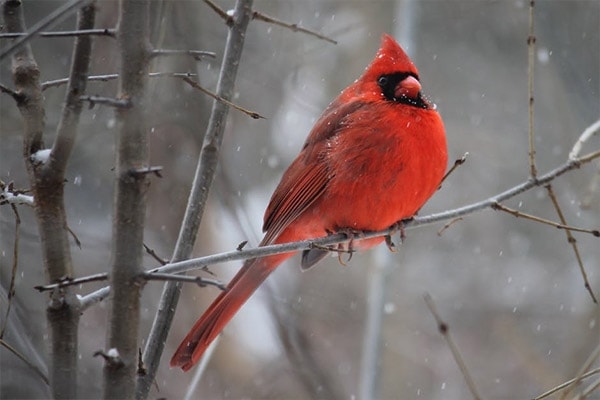
photo credit: Harvey Reed from Pexels
The Northern Cardinal is everyone’s favorite bird. In fact, seven states and several schools have used these birds as symbols. Their bright red-orange color brings brightness to your backyard, regardless of what season it is. Their sweet songs can also sweeten everyone’s day as it’s the first music you’ll hear in the morning.
In this article, we are going to cover a wide variety of topics related to the Northern Cardinal, such as:
- How to identify them
- How, when, and where they migrate
- Their diet
- How and where they nest
- And much more…
So, without any more delay…
Let’s jump right into it and learn more about the Northern Cardinal.
Northern Cardinal Facts
- Common Name: Northern Cardinal
- Scientific Name: Cardinalis cardinalis
- Scientific Family: Cardinalidae
- Life Span: 3 years
- Size: 8.3 to 9.1 inches
- Wingspan: 9.8 to 12.2 inches
- Weight: 1.5 to 1.7 oz
- Conservation status: Least concern
How To Identify A Northern Cardinal
Northern Cardinals are medium-sized birds with red-orange beaks, long tails, and a standing crest on top of their heads. The only difference between the male and female is their color pattern.
Differences Between Male & Female
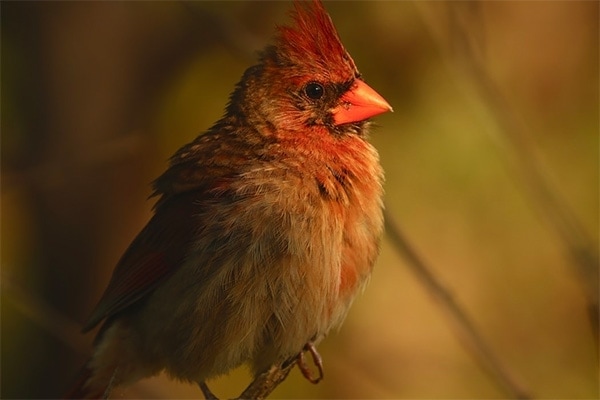
photo credit: Ryk Naves on Unsplash
Male Northern Cardinals feature a red color all over their bodies, from the top of their heads to the tip of their tails. The face area down to their throat is a deep black color.
On the other hand, female Northern Cardinals have a pale brown color pattern all over their body. The wings, tail, and crest have a hint of red color right on the edges.
Differences In Summer Plumage vs Winter Plumage
Northern Cardinals look the same throughout the year, regardless if it’s winter or summer. However, there are rare occasions where Northern Cardinals go bald, showing black or dark skin.
Northern Cardinal Sounds
Where You’ll See A Northern Cardinal
Northern Cardinals are the familiar and famous redbird of the United States. They are found all over the southeastern part of the US, but now also extending up north and the central United States. With their increasing popularity, seven states have considered this bird as their official state bird.
These birds are found in a variety of habitats. They love dense shrubby areas like the forest edges, landscaped areas, overgrown fields, and more. They love spending time in backyards, too, and feed in bird feeders.
Northern Cardinal Migration Patterns
Northern Cardinals are resident birds. They are found year-round in one place, coloring the environment, even in winter.
Diet and Feeding Preferences
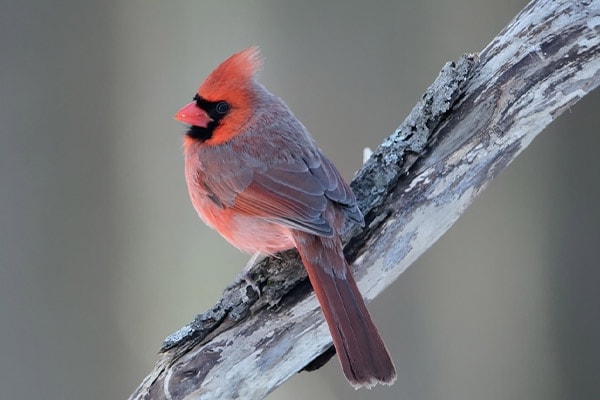
photo credit: Naturelady from Pixabay
Northern Cardinals have a varied diet, from insects to seeds to berries. About 90% of their diet is plant-based, eating seeds, fruits, and grains throughout the season, while occasionally eating insects.
They most especially love seeds that are easy to open. But when winter comes and food becomes less abundant, these birds are no longer too picky of what they eat.
Nesting Data
- Clutch Size: 2-5 eggs
- # of Broods: 1-2 broods
- Incubation Period: 11-13 days
- Nestling Period: 7-13 days
- Egg Description: Pale gray, light blue, or light green with dark dots
Nesting
Northern Cardinals start pairing in the early spring. While courting, both the male and female birds sway and dance with their heads high while singing softly.
It’s the female birds that search for nest sites. This can be in a fork of small branches, in a shrub, or even in a vine. It’s usually 1-15 feet high and also hidden away from predators.
While the female does the building, the male brings the nest materials to her. The female will then create a four-layer cup-shaped nest of coarse twigs, weeds, grass, tree barks, leaves, and rootlets, which will then be lined with fine grasses, rootlets, and pine needles.
It usually takes 7-13 days to finish a nest, and sometimes they don’t even use the same nest for the next breeding seasons.
Northern Cardinal Behavior
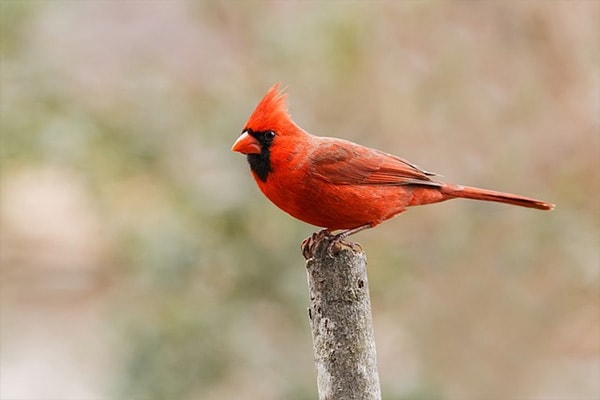
photo credit: TheBirdBird from Pixabay
Northern Cardinals are diurnal birds, spending most of their daytime hopping in low branches of the trees and finding food sources near the ground. They are also commonly seen singing in high branches.
Slightly social birds, Northern Cardinals form into large flocks during fall and winter seasons. They also sometimes search for food with other bird species, including a lot of sparrow birds.
Once the breeding season comes, Northern Cardinals form in pairs and become very territorial. Male birds, in particular, become extremely territorial, charging at any bird that intrudes their territory.
Tips for Birdwatchers On How To Attract Northern Cardinals
Unless you’re in the southeastern part of the United States, you won’t be able to attract Northern Cardinals to your backyard. But for those in the southeastern states and want to give some bright color in your backyard, Northern Cardinals are very easy to attract.
Just like with other birds, you only need to fulfill the Northern Cardinals’ needs. Alter your backyard to what Northern Cardinal likes, from their food to their nesting needs.
Northern Cardinals love eating in secure places. Since they are heavy birds, hanging feeders are not the best choice. You should opt for sturdy platform feeders or a hopper feeder to give them enough space.
These birds are not picky, and they eat almost anything, especially during the winter season. If you want to give them bird seeds, sunflower seeds and safflower seeds are their favorite. But you can also place corn, suet, mealworms, peanuts, and chips on the bird feeders.
Since the birds also love eating berries, planting some blueberry, sumac, and mulberry trees and shrubs is a great idea. You can grow any colored berries you want. On top of that, plant other bushes, shrubs, and thick vines to serve as shelter for the birds.
If you want the Northern Cardinals to nest in your backyard, provide nesting sites and nesting materials for them, too. Scatter some twigs, grass clipping, or pine needles around your backyard that the birds can find.
But most of all, you must provide sufficient water for drinking and bathing, too. And since Northern Cardinals may also visit your backyard during winter, heated bird baths are a great choice.
Threats To The Northern Cardinal
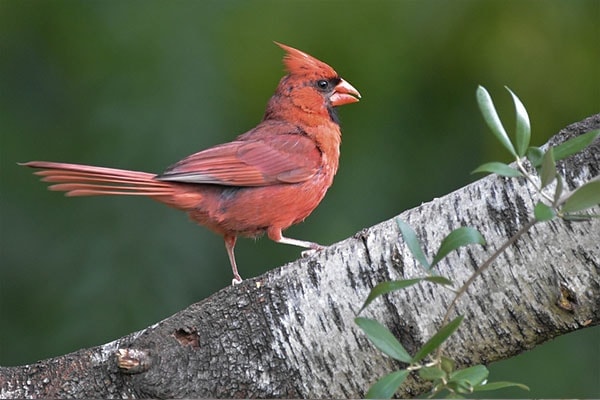
photo credit: Jack Bulmer from Pixabay
Northern Cardinals have shown a significant increase in their numbers, probably due to the many available backyards that can accept them. However, there has been a considerable loss of habitats in southeastern California and might cause a huge population loss of birds there.
Other than that, predators are also everywhere. A few common predators include domestic cats and dogs, hawks, squirrels, owls, snakes, and chipmunks. Brown-headed cowbirds are also found to be a threat to the Northern Cardinal eggs.
Fun & Interesting Facts
- The Northern Cardinal is the state bird of seven states – Illinois, Indiana, Ohio, West Virginia, Kentucky, North Carolina, and Virginia.
- Male Northern Cardinals can be too aggressive that they sometimes attack their reflections.
- It’s the mascot of Iowa State University.
- Different schools have used the northern Cardinals as their symbol.
- The range of Northern Cardinals is slowly shifting north.
- The birds get their red color from what they eat, as most of their foods contain carotenoids.
- Unlike most other bird species, female Northern Cardinals also sing.
- The birds are named cardinals as their bright red color resembles the red vestments of Catholic cardinals, and their crest is similar to the headgear of higher religious officials.
- The oldest recorded Northern Cardinal lived for 15 years and 9 months.
Explore More Species in This Family
- Hepatic Tanager
- Summer Tanager
- Scarlet Tanager
- Western Tanager
- Pyrrhuloxia
- Rose-breasted Grosbeak
- Black-headed Grosbeak
- Blue Grosbeak
- Lazuli Bunting
- Indigo Bunting
- Varied Bunting
- Painted bunting
- Dickcissel
The post Northern Cardinal: Bird Identification, Habits, Facts, Nesting appeared first on BirdInformer.com.
from BirdInformer.com https://ift.tt/38vz8Sw

No comments:
Post a Comment